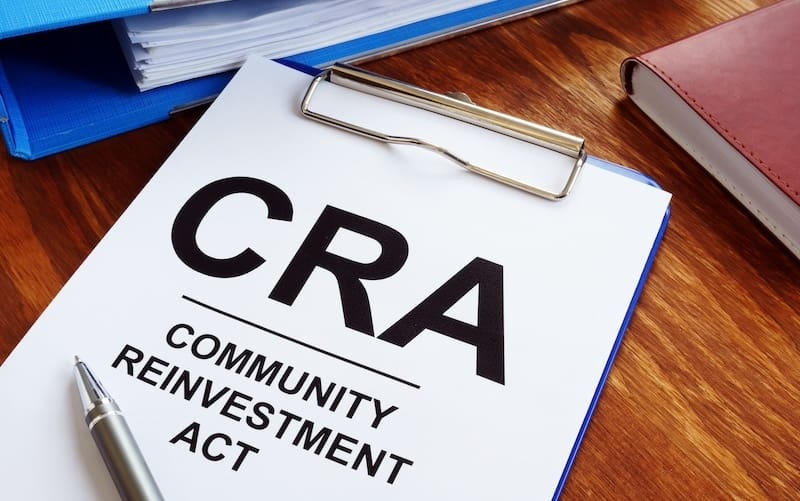
The Community Reinvestment Act is a federal statute encouraging banks to support communities. Unfortunately, it lacks a strategy to address the root causes of climate change. Photo: Shutterstock
For too long, low-income communities have borne the brunt of the extreme weather we’ve been experiencing, from worsening heat waves to more powerful storms. Vulnerable communities with historic disinvestment have been largely left to fend for themselves.
Now, our federal banking agencies have just missed a historic opportunity to address the problem. The Federal Deposit Insurance Corporation, Federal Reserve, and Office of the Comptroller of the Currency have failed to recognize the root causes of the climate crisis. By thinking short-term in recently revised rules, federal agencies have further disadvantaged environmental justice neighborhoods already suffering from the outsized burdens of polluting infrastructure and now climate change.
We won’t accept polluted water, dangerous heat, and unpredictable energy costs as foregone conclusions in our communities—and our banks shouldn’t either. Instead, banks should work to enrich our communities with long-term, sustainable solutions that will improve residents’ health and welfare.
Weather Resiliency vs. Climate Resiliency
When creating federal policy that holds banks accountable for their investments in climate resiliency, a lot hinges on the specific language in that policy – in this case, “weather resiliency” vs. “climate resiliency.”
“Weather resiliency” is the language the three federal agencies used in the most recent revisions to the Community Reinvestment Act (CRA). This federal statute encourages banks to support all communities they serve. But this phrase ultimately signals short-term thinking with no real strategy to address the root causes of the climate crisis.
While weather and climate resiliency might seem interchangeable at first glance, they have critical distinctions when it comes to policymaking and the realized effects of these policies on communities.
“Weather resiliency” refers to creating infrastructure to manage the impact of extreme weather events, such as a floodplain system to reduce flood damage or an emergency generator for extended power outages.
“Climate resiliency,” on the other hand, is a more ambitious term; it aims to empower communities with new energy infrastructure. What if we didn’t resign ourselves to using the dirty energy that causes extreme weather events? What if, instead of addressing the effects of a problem that will only worsen with time, we focused on striking the issue’s root—investments in fossil fuels? The federal government has no provisions for climate resiliency in the newest Community Reinvestment Act amendments, a concerning reality given the quickening pace of climate change.
Without investments to counteract these root causes of climate change, bank investments may fail to protect our communities’ future.
A Missed Opportunity to Modernize Investment
The Community Reinvestment Act requires banks to invest in communities of different kinds through a scoring system. The scoring system ranks banks’ compliance with certain dimensions of community investment. This information is then used by bank regulators when considering the approval of new bank locations, mergers, and acquisitions—in other words, the government can penalize noncompliant banks that don’t reinvest in their communities.
For the first time since 1995, changes to the Act were approved, modernizing how banks are asked to support their communities. Initial revisions included “climate resiliency” as a parameter for investment, but the final draft, completed in 2023 and set to go into effect in 2026, only lists “weather resiliency” and “disaster preparedness” without any mention of clean energy investments, climate change, or global warming. In other words, the act might support investments in flood control systems without addressing the issue of flooding itself or create an emergency power generator rather than shifting resources towards more resilient and clean power altogether.
How We’re Taking Action
We cannot ignore climate change and adopt a reactive stance that compounds the inequities communities feel. We also cannot afford to compound the dollars spent to rebuild continuously after disasters. For that reason, CLF is offering a way to help investors proactively address climate change. Through the Healthy Neighborhoods Research Consortium, we’ve developed our own accountability metrics for investments in climate resiliency.
Our climate accountability metrics pick up where the Community Reinvestment Act leaves off. Our metrics are a kind of performance benchmark that allows bank investors to keep the needs and strengths of communities at the forefront of their investment decision-making. For example, our metrics measure a project’s level of authentic community engagement, including accessible meeting spaces and community surveys in multiple languages. Our metrics also evaluate whether a project strengthens social support networks in a climate-vulnerable community. We hope our climate accountability metrics can offer data to guide bank investments toward greener infrastructure –like accessible parks– while spurring community engagement.
Community health is symbiotic with environmental health. If we hope to foster thriving neighborhoods for decades to come, we must invest capital in communities where it is needed most. Planning for and investing in climate resiliency is one way to do that.
Daniel Miner is a political science and sociology major at Tufts University. He served as a Healthy and Resilient Communities intern at Conservation Law Foundation in the summer of 2024.



